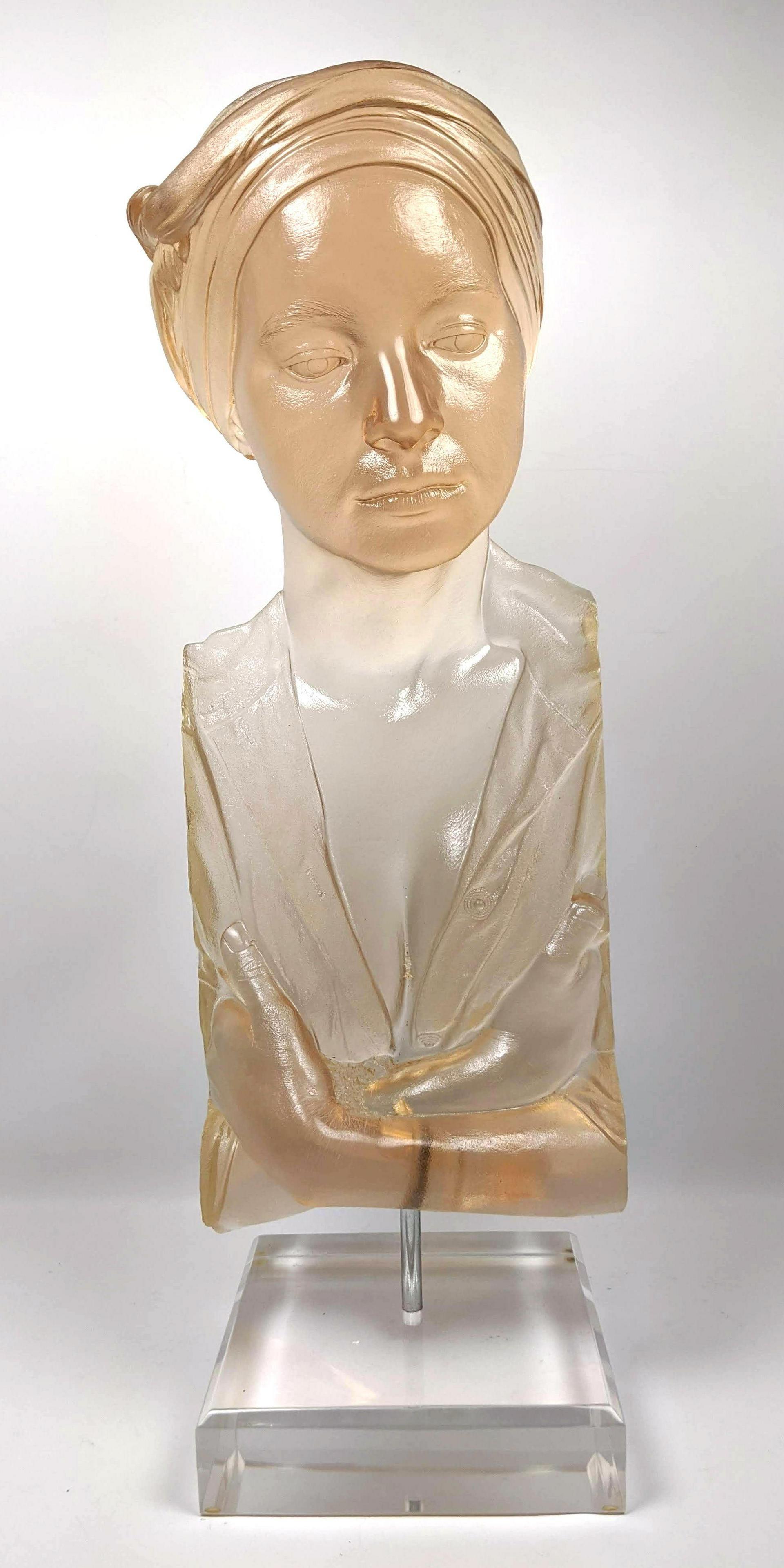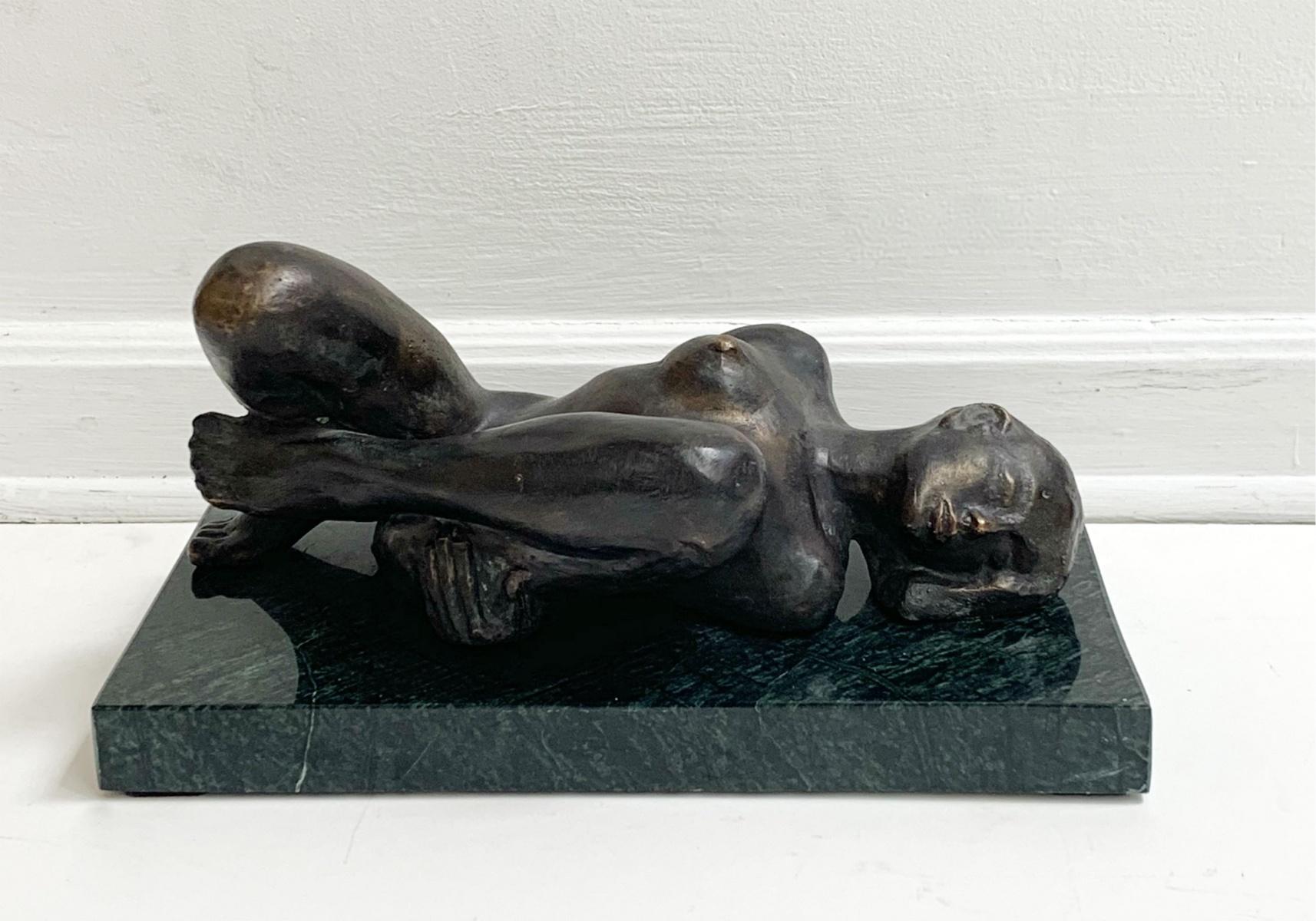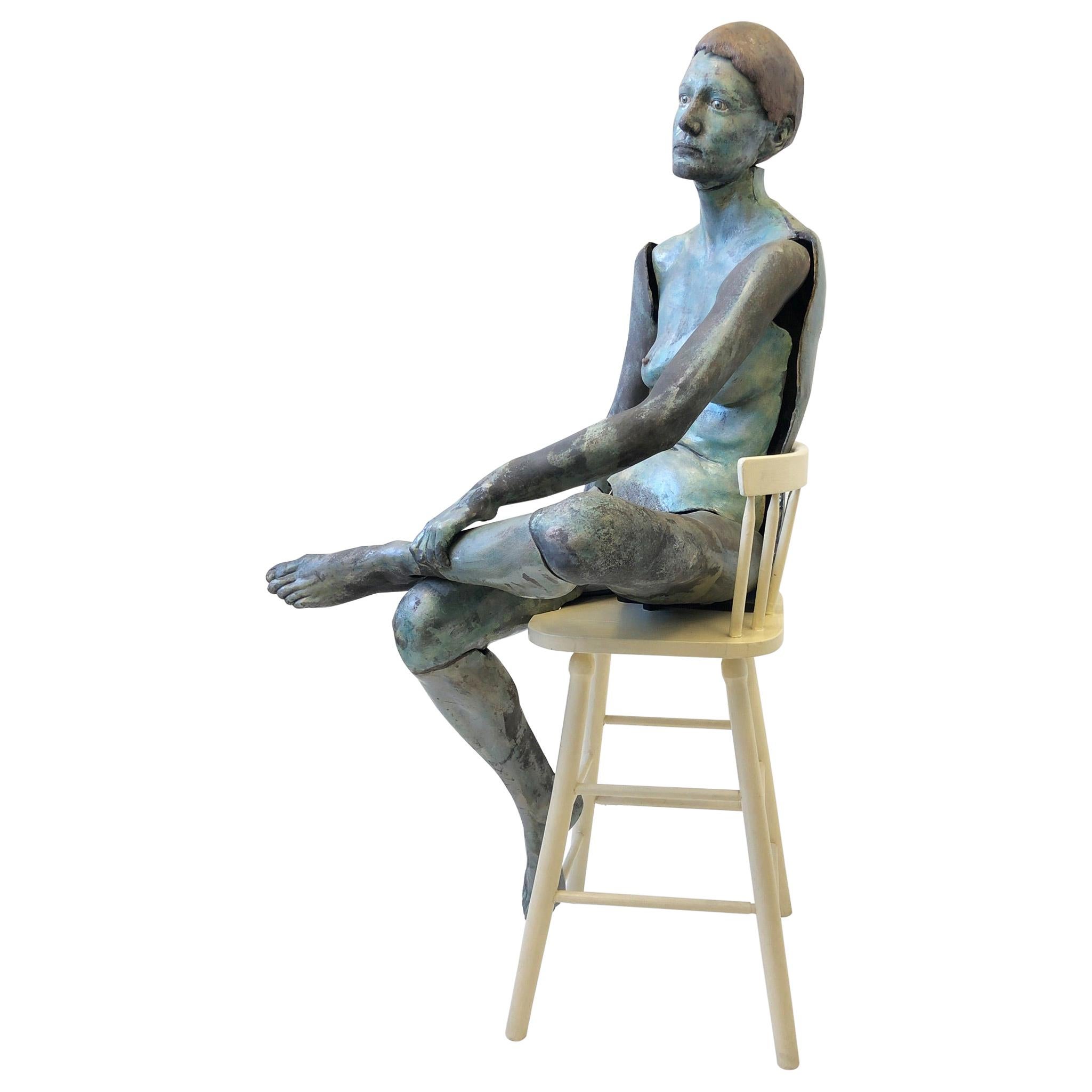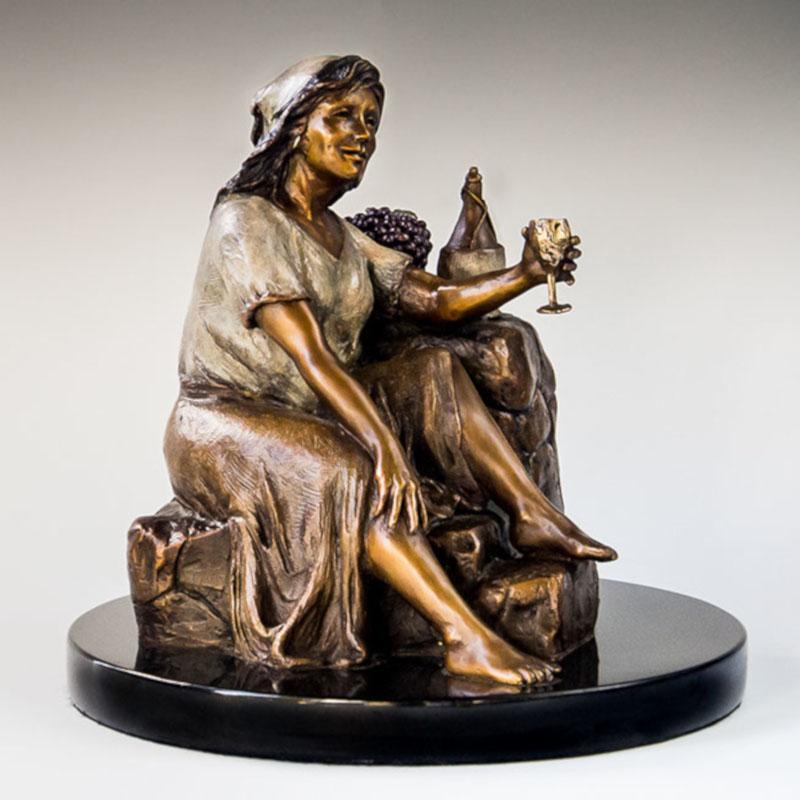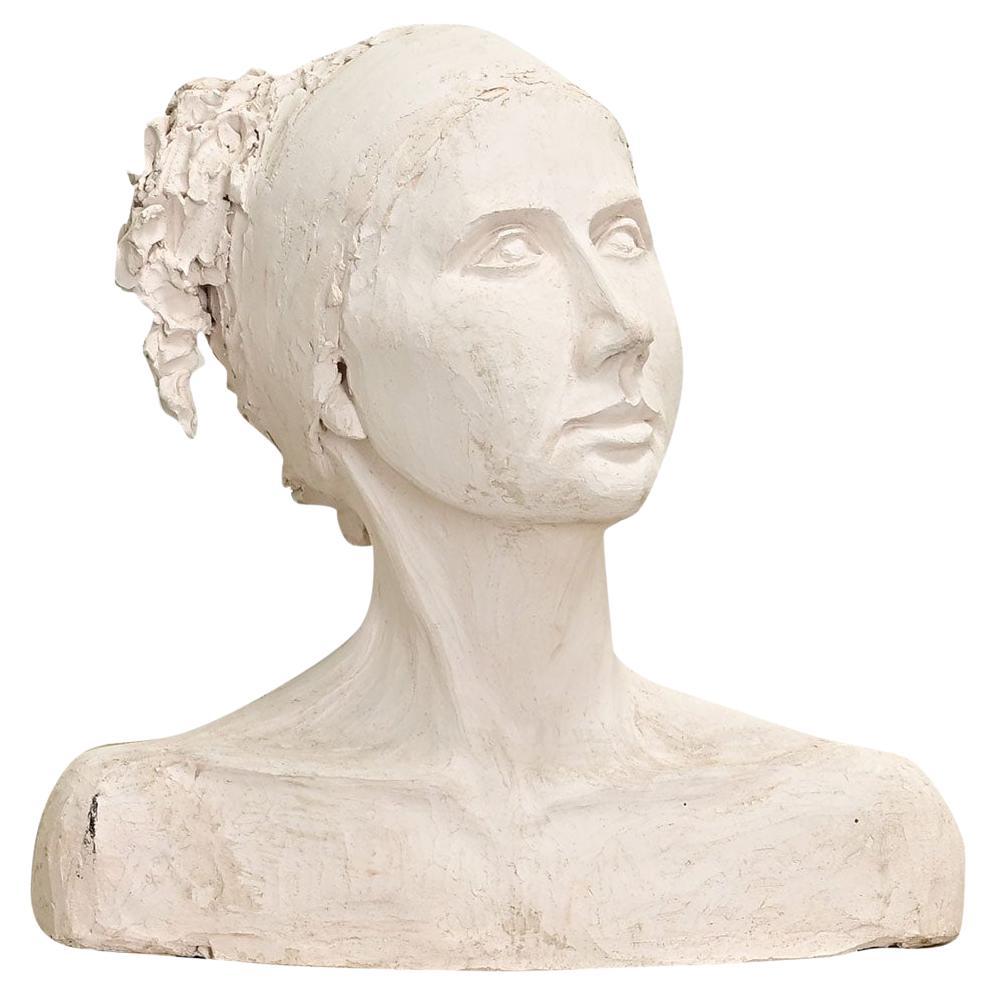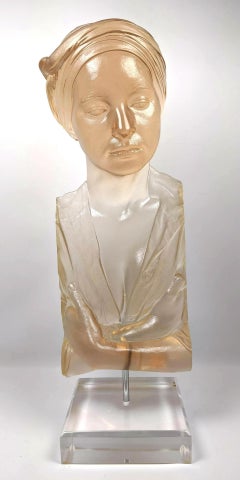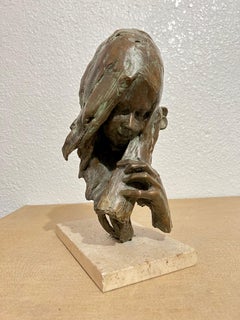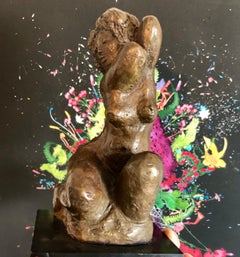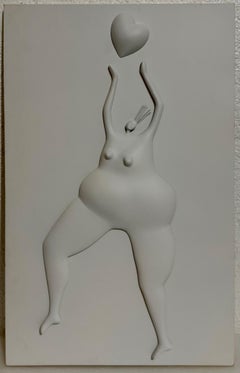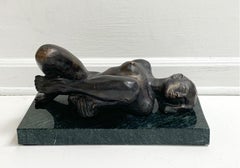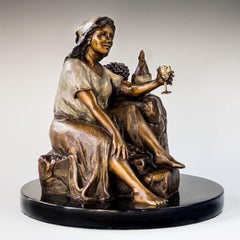Items Similar to Marc Sijan Hyperrealist Contemporary Plaster Sculpture Woman and Champagne Glass
Want more images or videos?
Request additional images or videos from the seller
1 of 16
Marc SijanMarc Sijan Hyperrealist Contemporary Plaster Sculpture Woman and Champagne Glass1986
1986
$7,500
£5,689.96
€6,523.87
CA$10,684.20
A$11,594.98
CHF 6,100.78
MX$140,879.36
NOK 76,380.65
SEK 71,919.33
DKK 48,710.77
About the Item
Marc Sijan (American, born 1946)
Hyper realistic wall sculpture. titled and dated on verso
"Champagne Glass"
1986
Limited edition number 14/95. Features a Art Deco style girl in hyper realism holding a champagne glass. Artist hand signed on verso.
Dimensions: 29.5 X 19.5 X 17 in.
A cast hydrocal plaster sculpture titled Champagne Glass by American artist Marc Sijan. Her eyes are closed and her head is tilted up as if in bliss.
Marc Sijan, Serbian American artist and sculptor born 1946. Known for his hyper-realistic portrait sculpture. He received his Bachelor's degree in art education from the University of Wisconsin in 1968, then went on to complete a Master of Science in Art degree three years later in 1971, undertaking an intense study of anatomy and biology. He lives and works in Milwaukee, USA.
Sijan works within the tradition of figurative sculpture, but uses a modern approach. His meticulous creative process begins with the construction of a plaster mould from a live model. He then uses a magnifying glass to sculpt the interior of the mould in order to assure that each detail is super realistic and accurate, before casting the figure in resin. Realistic flesh tones are then achieved with multiple layers of oil paint and varnish, a process that takes around six months to complete. His sculptures are so life-like as to almost be on the verge of movement. He mostly depicts people that are often overlooked by our society such as blue collared workers or cleaning staff, turning the ordinary into extraordinary works of art.
Sijan, a Milwaukee-based artist, carries on the tradition of a very old form, but his approach is very modern. His realism recalls the work of the Greek sculptors in its bold expression of human energy and poise. Sijan's method is distinct and exacting. First, he works from live models, to produce a negative mold in plaster, and sculpts the interior with special tools and a magnifying glass to assure accurate detail. Then, he casts the figure in a polyester resin. To achieve realistic flesh tones, Sijan applies 25 coats of paint --- and adds varnish. Sijan uses oil painting in the final stages of the work. "The goal is to achieve depth, yet translucency," he says. "It can't be flat. The chest and throat texture is different from that of the arms, legs and stomach. Facial skin differs from that on the torso." Hyperrealism is a genre of painting and sculpture resembling a high-resolution photograph. Hyperrealism is considered an advancement of Photorealism by the methods used to create the resulting paintings or sculptures.
Belgian art dealer Isy Brachot coined the French word Hyperréalisme, meaning Hyperrealism, as the title of a major exhibition and catalogue at his gallery in Brussels in 1973. The exhibition was dominated by such American Photorealists as Ralph Goings, Chuck Close, Don Eddy, Audrey Flack, Robert Bechtle and Richard McLean; but it included such influential European artists as Domenico Gnoli, Gerhard Richter, Konrad Klapheck, Gottfried Helnwein and Roland Delcol. Since then, Hyperrealism has been used by European artists and dealers to apply to painters influenced by the Photorealists. It is also called super-realism or hyper-realism and painters like Richard Estes, Denis Peterson, Audrey Flack, and Chuck Close often worked from photographic stills to create paintings that appeared to be photographs.His creations have been featured in galleries, museums and special exhibits all over the world such as the Smithsonian Museum of Modern Art in Washington, D.C, the San Francisco Museum of Modern Art, the Philadelphia Museum of Modern Art, the Milwaukee Art Museum, the Delaware Art Museum, The Butler Institute of American Art And many more. Bruce Helander, the White House Fellow of the National Endowment for the Arts: “Hyperrealism came into vogue in the 1970s with the works of Duane Hanson and Carole Feuerman, whose recreations of everyday people were in a class of their own. Artist John De Andrea took the process a step further by recreating figures in their natural state. Today, sculptor Marc Sijan has become one of the most successful and innovative artists in the world. His work has brought hyper-illusion as another aesthetic component into modern figurative sculpture that is celebrated in museums and gallery exhibitions around the world. His work has won him recognition throughout the country, with over 50 one-man museum exhibitions worldwide, over half of which set all time attendance records. His work appears in permanent collections in over 30 international museums.
- Creator:Marc Sijan (1946, American)
- Creation Year:1986
- Dimensions:Height: 29.5 in (74.93 cm)Width: 19.5 in (49.53 cm)Depth: 17 in (43.18 cm)
- Medium:
- Movement & Style:
- Period:
- Condition:minor wear, please see photos.
- Gallery Location:Surfside, FL
- Reference Number:1stDibs: LU38216199302
About the Seller
4.9
Platinum Seller
Premium sellers with a 4.7+ rating and 24-hour response times
Established in 1995
1stDibs seller since 2014
1,812 sales on 1stDibs
Typical response time: 1 hour
- ShippingRetrieving quote...Shipping from: Surfside, FL
- Return Policy
Authenticity Guarantee
In the unlikely event there’s an issue with an item’s authenticity, contact us within 1 year for a full refund. DetailsMoney-Back Guarantee
If your item is not as described, is damaged in transit, or does not arrive, contact us within 7 days for a full refund. Details24-Hour Cancellation
You have a 24-hour grace period in which to reconsider your purchase, with no questions asked.Vetted Professional Sellers
Our world-class sellers must adhere to strict standards for service and quality, maintaining the integrity of our listings.Price-Match Guarantee
If you find that a seller listed the same item for a lower price elsewhere, we’ll match it.Trusted Global Delivery
Our best-in-class carrier network provides specialized shipping options worldwide, including custom delivery.More From This Seller
View AllMarc Sijan Hyper Realist Contemporary Cast Acrylic Resin Sculpture Portrait Bust
By Marc Sijan
Located in Surfside, FL
A cast acrylic sculpture titled Chin Up by American artist Marc Sijan. This sculpture is made from acrylic and portrays the upper torso of a clothed woman wearing a bandana over her ...
Category
20th Century Photorealist Figurative Sculptures
Materials
Resin, Lucite, Acrylic Polymer
Bronze Sculpture American Modernist Art Stanley Bleifeld Girl with Bass or Cello
By Stanley Bleifeld
Located in Surfside, FL
Retaining a fine patina and in overall good condition.
Signed with initials SB.
I believe the edition size was 7 But I cannot find a mark.
Stanley Bleifeld (1924 – 2011) was an American sculptor.
Stanley Bleifeld was born and raised in Brooklyn, New York, Bleifeld earned bachelor of fine arts, bachelor of science in education and in 1949 a master of fine arts degree in painting at Tyler School of Art of Temple University. After a trip to Rome in 1959 or 1960 he gave up painting for sculpture. He began his fine-art career as a painter. However, a visit to Italy and exposure to the bronzes of Donatello, Michelangelo, and Ghiberti changed his direction He worked with the Art Foundry of Massimo del Chiaro and alongside artists such as Lucchesi, Harry Marinsky, Fernando Botero, Igor Mitoraj and Ivan Theimer. Many of his early pieces were religious subjects, and reflected both painting and sculptural techniques in bas reliefs* that had "liquid landscapes in undulating reliefs and free-flowing portraits reminiscent of classical fragments" (166-167). He later turned from these abstract pieces to more realistic figures in bronze.
Bleifeld was a National Academician in Sculpture, and a member of the National Academy of Design, and helped set policy for that organization. He was also President of the National Sculpture Society. Past presidents of the society have included John Quincy Adams Ward, James Earle Fraser, Chester Beach, Wheeler Williams, Leo Friedlander, Neil Estern, and Cecil de Blaquiere Howard. The first woman to gain admission into the NSS was Theo Alice Ruggles Kitson, in 1893. She was followed a few years later by Enid Yandell and Bessie Potter Vonnoh in 1898; Janet Scudder in 1904; Anna Hyatt Huntington in 1905 and Evelyn Longman and Abastenia St. Leger Eberle in 1906. In 1946, Richmond Barthé was likely the first African-American to be admitted.
In 1994, the NSS held their first exhibition outside the United States at the Palazzo Mediceo Di Seravezza in Italy. Titled “100 Years of the National Sculpture Society of the United States of America in Italy” it ran from the 16th of July through the 4th of September and was curated by Nicky and Stanley Bleifeld along with Costantino Paolicchi, Lodovico Gierut and Paolo Giorgi. Among the 60 notable American sculptors whose work was selected for the exhibition were Stanley Bleifeld, Andrew DeVries, Neil Estern, Leonda Finke, Bruno Lucchesi, Barbara Lekberg...
Category
1970s American Modern Figurative Sculptures
Materials
Bronze
Bronze Female Nude Sculpture Modernist, WPA, New York Chelsea Hotel Artist
By Eugenie Gershoy
Located in Surfside, FL
Eugenie Gershoy (January 1, 1901 – May 8, 1986) was an American sculptor and watercolorist. Eugenie Gershoy was born in Krivoy Rog, Russia (Krivoi Rog, Ukraine) and emigrated to New York City in the United States as a child in 1903. Considered somewhat of a child prodigy, Gershoy was copying Old Master drawings at the age of 5. Her interest and talent in art was encouraged from a very young age. Aided by scholarships, she studied at the Art Students League under Alexander Stirling Calder, Leo Lentelli, Kenneth Hayes Miller, and Boardman Robinson. Around this time, she created a group of portrait figurines of her fellow artists, including Arnold Blanch, Lucile Blanch, Raphael Soyer, William Zorach, Concetta Scaravaglione, and Emil Ganso, which were exhibited as a group at the Whitney Museum of American Art. At age 17, she was awarded the Saint-Gaudens Medal for fine draughtsmanship. Early in her career she became an active member of the Woodstock art colony. In Woodstock she experimented by sculpting in the profusion of indigenous materials that she found. Working with fieldstone, oak and chestnut, Gershoy created works based on classic formulae. As she became more interested in the dynamism of everyday life, she found that these materials and her idiom were too restrictive. By the time Gershoy came to Woodstock in 1921 her own individual artistic style was already evident in her sculptures. Eugenie Gershoy worked in stone, bronze, terracotta, plaster and papier-mache. Gershoy’s sculptures were mainly figurative in nature and many of her artist peers such as Carl Walters, Raphael and Moses Soyer, William Zorach and Lucille Blanch, became her subjects. Eugenie Gershoy’s works on paper should not be overlooked. She was the winner of the Gaudens Medal for Fine Draughtsmanship at the tender age of 17. Gershoy married Jewish Romanian-born artist Harry Gottlieb. In the late 1920s and early 1930s, the pair kept a studio in Woodstock, New York. There, Gershoy was influenced by sculptor John Flanagan, who lived and worked nearby.
From 1936 to 1939, Gershoy worked for the WPA Federal Art Project. She collaborated with Max Spivak on murals for the children's recreation room of the Queens Borough Public Library in Astoria, New York. She developed a mixture of wheat paste, plaster, and egg tempera, which she used in polychrome papier-mâché sculptures; she was the only New York sculptor to work in polychrome at this time. She also designed cement and mosaic sculptures of animals and figures to be placed in New York City playgrounds. Alongside others employed by the FAP, she participated in a sit-down strike in Washington, DC, to advocate for better pay and improved working conditions for the projects' artists.
Gershoy's first solo exhibition was held at the Robinson Gallery in New York in 1940. She moved to San Francisco in 1942, and began teaching ceramics at the California School of Fine Arts in 1946. In 1950, she studied at the artists' colony at Yaddo.
Gershoy traveled extensively throughout her life. She visited England and France in the early 1930s, and worked in Paris in 1951. She traveled to Mexico and Guatemala in the late 1940s, and also toured Africa, India, and the Orient in 1955.
In 1977, Gershoy dedicated a sculpture to Audrey McMahon, who was actively involved in the creation of the Federal Art Project and served as its regional director in New York, in recognition of the work McMahon provided struggling artists in the 1930s.
Gershoy's work is in the collections of the Whitney Museum of American Art, the Metropolitan Museum of Art, and the Smithsonian American Art Museum. Her papers are held at Syracuse University Grant Arnold introduced her to lithography in 1930 and Gershoy depicted many scenes of Woodstock artists and their daily activities through this medium. From 1942 to 1966 Gershoy lived and painted in San Francisco where she taught at the San Francisco Art Institute. She traveled extensively, filling sketchbooks with scenes of Mexico, France, Spain, Africa and India. During her later years Eugenie Gershoy returned to New York City and concentrated on numerous well received exhibitions. Her last exhibition in at Sid Deutsch Gallery included many of the sculptures that were later exhibited in the Fletcher Gallery.
John Russell, former chief critic of fine arts for the New York Times, writes about the 1986 Sid Deutsch exhibition:
“As Eugenie Gershoy won the Saint-Gaudens Medal for fine draftsmanship as long ago as 1914 and since 1967 has had 15 papier-mache portrait figures suspended from the ceiling of the lobby of the Hotel Chelsea, she must be ranked as a veteran of the New York scene. Her present exhibition includes not only the high-spirited papier-mache sculptures for which she is best known but a group of small portraits of artists, mostly dating from the 30’s, that is strongly evocative.”
Eugenie Gershoy is an artist to take note of for several reasons. She was a woman who received great awards and recognition during a time when most female artists were struggling to hold their own against their male counterparts. As a young girl she won a scholarship to the Arts Student League where she met Hannah Small...
Category
Mid-20th Century American Modern Nude Sculptures
Materials
Bronze
Latin American Master Abigail Varela Sculpture Relief Plaque Woman with Heart
By Abigail Varela
Located in Surfside, FL
Abigail Varela (1948-)
Atrapando un corazón
2008
Madera, resina y acrílico
Catching a Heart
Wood, Resin and Acrylic
Hand signed verso with initials and dated
2008
This is a rare, u...
Category
Early 2000s Post-Modern Nude Sculptures
Materials
Resin, Wood, Acrylic
Brutalist Ceramic Sculpture Vase Bronze Lustre FInish California Expressionist
By Jenik Cook
Located in Surfside, FL
Jenik Cook
Handmade ceramic vase or pot sculpture
Hand signed by the artist.
Fired clay with a luster bronze painted finish
Jenik Esterm Simonian Cook is a painter and ceramicist ...
Category
20th Century Abstract Expressionist Figurative Sculptures
Materials
Ceramic, Luster, Paint
Bronze Sculpture Flutist American Modernist Art Stanley Bleifeld Girl with Flute
By Stanley Bleifeld
Located in Surfside, FL
Retaining a fine patina and in overall good condition.
Signed with initials SB.
I believe the edition size was 7 But I cannot find a mark.
Stanley Bleifeld (1924 – 2011) was an American sculptor.
Stanley Bleifeld was born and raised in Brooklyn, New York, Bleifeld earned bachelor of fine arts, bachelor of science in education and in 1949 a master of fine arts degree in painting at Tyler School of Art of Temple University. After a trip to Rome in 1959 or 1960 he gave up painting for sculpture. He began his fine-art career as a painter. However, a visit to Italy and exposure to the bronzes of Donatello, Michelangelo, and Ghiberti changed his direction He worked with the Art Foundry of Massimo del Chiaro and alongside artists such as Lucchesi, Harry Marinsky, Fernando Botero, Igor Mitoraj and Ivan Theimer. Many of his early pieces were religious subjects, and reflected both painting and sculptural techniques in bas reliefs* that had "liquid landscapes in undulating reliefs and free-flowing portraits reminiscent of classical fragments" (166-167). He later turned from these abstract pieces to more realistic figures in bronze.
Bleifeld was a National Academician in Sculpture, and a member of the National Academy of Design, and helped set policy for that organization. He was also President of the National Sculpture Society. Past presidents of the society have included John Quincy Adams Ward, James Earle Fraser, Chester Beach, Wheeler Williams, Leo Friedlander, Neil Estern, and Cecil de Blaquiere Howard. The first woman to gain admission into the NSS was Theo Alice Ruggles Kitson, in 1893. She was followed a few years later by Enid Yandell and Bessie Potter Vonnoh in 1898; Janet Scudder in 1904; Anna Hyatt Huntington in 1905 and Evelyn Longman and Abastenia St. Leger Eberle in 1906. In 1946, Richmond Barthé was likely the first African-American to be admitted.
In 1994, the NSS held their first exhibition outside the United States at the Palazzo Mediceo Di Seravezza in Italy. Titled “100 Years of the National Sculpture Society of the United States of America in Italy” it ran from the 16th of July through the 4th of September and was curated by Nicky and Stanley Bleifeld along with Costantino Paolicchi, Lodovico Gierut and Paolo Giorgi. Among the 60 notable American sculptors whose work was selected for the exhibition were Stanley Bleifeld, Andrew DeVries, Neil Estern, Leonda Finke, Bruno Lucchesi, Barbara Lekberg...
Category
1970s American Modern Figurative Sculptures
Materials
Bronze
You May Also Like
Woman - XXI century Contemporary figurative bronze sculpture, Classical, Realism
By Ryszard Piotrowski
Located in Warsaw, PL
RYSZARD PIOTROWSKI (born in 1952) Sculptor. He graduated from the Academy of Fine Arts in Warsaw. His works include intimate, small forms in marble, bronze and silver. He specializes...
Category
21st Century and Contemporary Contemporary Figurative Sculptures
Materials
Marble, Bronze
Italy Cast Lost Wax Woman Figurine Bronze Sculpture by Aron Demetz Guardando
By Aron Demetz
Located in Brescia, IT
This intense bronze sculpture was made by the well known Italian artist, Aron Demetz, in 2004, Italy.
This is a lost wax bronze hand painted. The title is "Guardando" translated in ...
Category
Early 2000s Post-Modern Figurative Sculptures
Materials
Bronze
Life-Size Ceramic Female Sculpture by Eva Stettner
Located in Palm Springs, CA
A spectacular 1980s Raku-fired ceramic female nude sculpture by Eva Stettner. The female sculpture is constructed of sections of ceramic that’s low fired ...
Category
Vintage 1980s American Modern Figurative Sculptures
Materials
Ceramic, Wood
"LA DOLCE VITA" WOMAN WITH WINE
Located in San Antonio, TX
Scy
Colorado / Texas Artist
Image Size: 13 inches tall
"La Dolce Vita"
Scy has been surrounded by fine art throughout her entire life. She grew up beside the easel and sculpting stand...
Category
2010s Impressionist Figurative Sculptures
Materials
Bronze
Vintage Plaster Statue of a Lady
Located in Baton Rouge, LA
A life-like scale and replica of a lady. Impressive craftsmanship and details can be found on this bust made of plaster. Be sure to view all the details from every angle.
Category
20th Century French Other Figurative Sculptures
Materials
Plaster
Nude - XXI century, Contemporary figurative marble sculpture, Classical, Realism
By Ryszard Piotrowski
Located in Warsaw, PL
RYSZARD PIOTROWSKI (born in 1952) Sculptor. He graduated from the Academy of Fine Arts in Warsaw. His works include intimate, small forms in marble, bronze and silver. He specializes...
Category
21st Century and Contemporary Contemporary Figurative Sculptures
Materials
Marble
More Ways To Browse
Used Champagne Glasses
Figurative Glass Sculpture
Vintage Champagne Glasses
Head Of A Woman Sculpture
Vintage Champagne Art
Champagne Sign
Cast Plaster Sculpture
Vintage French Coins
Plaster Woman Sculpture
Woman Glass Sculpture
Vintage Art Deco Plaster Figure Art Deco
John De Andrea
Atilla Tivadar
Aztec Sculpture Mosaic
Banksy Bearbrick
Bear Sahara Novotny
Bertoni 1949
Bill Mack Bonded Sand
